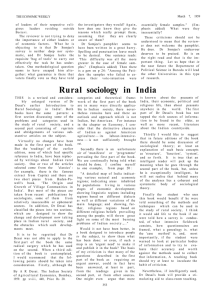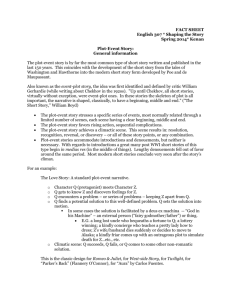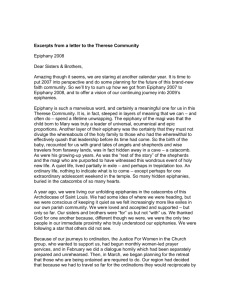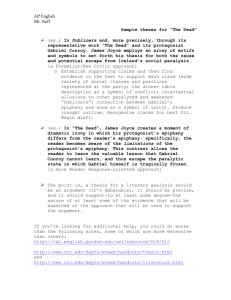Contemporary Literary Criticism | Desai, Anita (Vol
advertisement
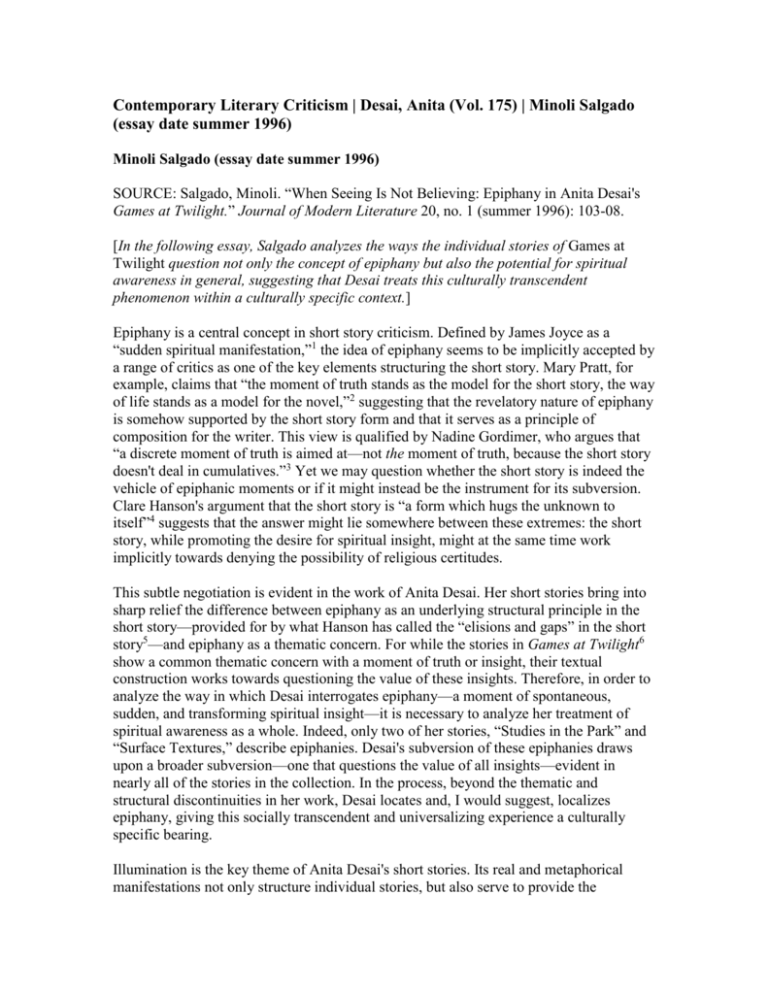
Contemporary Literary Criticism | Desai, Anita (Vol. 175) | Minoli Salgado (essay date summer 1996) Minoli Salgado (essay date summer 1996) SOURCE: Salgado, Minoli. “When Seeing Is Not Believing: Epiphany in Anita Desai's Games at Twilight.” Journal of Modern Literature 20, no. 1 (summer 1996): 103-08. [In the following essay, Salgado analyzes the ways the individual stories of Games at Twilight question not only the concept of epiphany but also the potential for spiritual awareness in general, suggesting that Desai treats this culturally transcendent phenomenon within a culturally specific context.] Epiphany is a central concept in short story criticism. Defined by James Joyce as a “sudden spiritual manifestation,”1 the idea of epiphany seems to be implicitly accepted by a range of critics as one of the key elements structuring the short story. Mary Pratt, for example, claims that “the moment of truth stands as the model for the short story, the way of life stands as a model for the novel,”2 suggesting that the revelatory nature of epiphany is somehow supported by the short story form and that it serves as a principle of composition for the writer. This view is qualified by Nadine Gordimer, who argues that “a discrete moment of truth is aimed at—not the moment of truth, because the short story doesn't deal in cumulatives.”3 Yet we may question whether the short story is indeed the vehicle of epiphanic moments or if it might instead be the instrument for its subversion. Clare Hanson's argument that the short story is “a form which hugs the unknown to itself”4 suggests that the answer might lie somewhere between these extremes: the short story, while promoting the desire for spiritual insight, might at the same time work implicitly towards denying the possibility of religious certitudes. This subtle negotiation is evident in the work of Anita Desai. Her short stories bring into sharp relief the difference between epiphany as an underlying structural principle in the short story—provided for by what Hanson has called the “elisions and gaps” in the short story5—and epiphany as a thematic concern. For while the stories in Games at Twilight6 show a common thematic concern with a moment of truth or insight, their textual construction works towards questioning the value of these insights. Therefore, in order to analyze the way in which Desai interrogates epiphany—a moment of spontaneous, sudden, and transforming spiritual insight—it is necessary to analyze her treatment of spiritual awareness as a whole. Indeed, only two of her stories, “Studies in the Park” and “Surface Textures,” describe epiphanies. Desai's subversion of these epiphanies draws upon a broader subversion—one that questions the value of all insights—evident in nearly all of the stories in the collection. In the process, beyond the thematic and structural discontinuities in her work, Desai locates and, I would suggest, localizes epiphany, giving this socially transcendent and universalizing experience a culturally specific bearing. Illumination is the key theme of Anita Desai's short stories. Its real and metaphorical manifestations not only structure individual stories, but also serve to provide the collection's overall pattern—that element of fiction which Desai has claimed is of most concern to her.7 The stories move between the “light” of insight, however fleeting, and the “dark” of indifference, between a development towards a moment of truth and an acknowledgement of the elusiveness of individual vision. But, as the very title of the collection, Games at Twilight, suggests, the stories describe potential and partial illumination. Desai conveys this sense of partial illumination by yoking a character's renewed awareness to the twilight hours. Twilight is the time when Raghu learns about the ignominy of defeat in the title story; it is the hour of release for Basu as he finally gains some peace in “Pigeons at Dawn”; it is the best time for revision and reflection, as Suno discovers in “Studies in the Park”; it is the hour of conviviality both forced and genuine in “The Farewell Party.” In all of these stories the conjunction between time and renewed awareness is used to affirm a dream time, a time when the imagination is released, a time when Scheherazade can begin her work of storytelling. It is, in other words, a time for the suspension of belief. This is significant, for it allows Desai to throw into doubt the value if not the validity of the insights gained by her characters. Desai creates ambiguity in her depiction of spiritual insight by combining disruptions of form with implicit social commentary. Thus, she successfully uses various methods to convey a twilight quality: the tense changes in the first-person narratives of “Studies in the Park” and “The Accompanist” emphasize developments in the state of mind of the central character, and the restless shift of focus from one character to another in “Games at Twilight,” “The Farewell Party,” and “Scholar and Gypsy” draws attention to the temporality and transience of a suspended state of consciousness. This fluid form destabilizes the potential for a unified focus or moral center to the texts. Yet Desai does not stop here. She highlights the divergence between twilight and daylight awareness, exploring the spiritual and emotional conflicts generated by the urge for the fulfillment of self-reflection and the need to meet social obligations and material demands. This conflict is explored in the story of Mr. Bose, who continues to provide private tuition despite finding it “intolerable, all of it—except … for the seventy-five rupees paid at the end of the month” (p. 16). He discovers that “the two halves of the difficult world he had been holding so carefully together, sealing them with reams of poetry, reams of Sanskrit, had split apart into dissonance” (p. 17). The fragile harmony at the end of “Private Tuition by Mr. Bose” is conveyed in suitably aesthetic terms—literature and music providing the idiom for an uneasy reconciliation and acceptance: … the grammar re-arranged itself according to rule, corrected itself. The composition into quiet made quite clear the exhaustion of the child, asleep or nearly so. The sounds of dinner being prepared were calm, decorative even. Once more the radio was tuned to music sympathetically sad. (p. 19) The harmony created between Mr. Bose and his environment is quite clearly an aesthetic construct—his newly acquired tranquillity described as a fabrication, a “composition into quiet,” and it is this overt aestheticism that draws attention to the author's presence. It is as if Desai has stepped out from the shadows to reveal that Bose's state of mind is constructed from an awareness that lies outside his own. The passage provides a gloss of unity and harmony, delineating an aesthetic resolution of material conflict. Yet this exposure of the artifice that goes into the construction of a character's awareness not only draws attention to the external presence of the writer—thereby disrupting a hitherto seamless narrative—but also emphasizes the very exteriority of this moment of reflection, calling into question its authenticity and value. This technique for destabilizing individual insight through self-conscious aestheticism is carried over into Desai's treatment of epiphany. In “Studies in the Park,” Suno, a stressed student, tries to concentrate on reviewing for his exams in a provincial park. There he sees something that, in his words, “burnt the surfaces of my eyes so that they watered” (p. 31). The exact import of his insight is, significantly, left unclear; what dominates is the form which his vision takes. It is a vision of a young woman whom he believes to be dying. The sight of her makes him feel as if he “were gazing at a painting or a sculpture, some work of art” (p. 30). Suno compares the woman's face to “a flower, wax-white and composed, like a Persian lily or a tobacco flower at night” and sees in it “a beauty I had never come across even in a dream”; he assumes that her paleness indicates that she is dying and even attempts a diagnosis—“she was very ill, with anaemia, perhaps, or t.b.”— and wonders if the old man accompanying her is “her husband, her father, her lover?” interpreting the intimacy between them as “inhuman” and “divine” (p. 30). Upon this brief glimpse of strangers in the park rests an undefined insight that liberates Suno from his social responsibilities, leading him to abandon his forthcoming exams and his familial commitments. There is clearly an ironic distance here between the immanent author and the central character—a disjunction allowed for by the use of a first-person narrative rich in hyperbole and melodrama. Although the epiphany is undoubtedly a genuine experience for the central character, Desai's depiction invites the reader to make judgments about it. She not only shows the epiphany to be based upon a vast number of suppositions, but the overtly romantic rendition of her character's experience suggests that it is shaped by an aesthetic idealism that renders it immature and vacuous—the product of a highly romantic, self-serving imagination. What is more, his vision of death in life so closely corresponds to Suno's own sense of futility over his exams that it suggests that his epiphany draws upon a desire to escape from exam pressures. This depiction of epiphany as an escape from social pressures is supported by Desai's treatment of spiritual awareness in general. In “Scholar and Gypsy,” Desai wryly juxtaposes an American woman's self-discovery and newly awakened religious awareness with the rationalist perspective of her unimaginative husband. Pat, the American woman, describes her experience in typically extravagant terms as an “escape from India,” an escape from “all those Hindu horrors” and all “the greasy Indian masses, whining and cajoling and sneering” (p. 128). This escape involves a reductive, childlike impression of the mountain folk whose harsh life is idealized under Pat's new visionary awareness: “all they have is a black old kettle and a pack of wood on their backs, rope sandals and a few sheep, but they laugh and sing and go striding up the mountains like— like lords” (p. 129). Yet again Desai has developed a storyline that upholds the importance of individual insight while simultaneously creating a formal dissonance that questions the value of this insight. Destabilization is furthered by the context within which spiritual experience occurs: if the only option for a spiritually transformed person such as Suno is to opt out of society altogether (a pattern also found in the epiphanic story “Surface Textures”), it implicitly calls into question the viability of the spiritual experience to penetrate the real contradictions of existence. In “Studies in the Park,” it is as if Desai self-consciously locates Suno's epiphany in a tangibly godless world, exposing the experience as a selfindulgent fabrication and thereby subverting its transcendental potential to break the boundaries between spiritual and material worlds. These boundaries form the subject of over half of the Twilight stories, in which Desai repeatedly draws attention to a character's failure to find a link between spiritual and material worlds, exposing the fragmentation of experience that is the very antithesis of epiphanic awareness. Art and artifice, she suggests, can provide a means of overcoming this fragmentation. Yet even in stories such as “The Accompanist” and “Sale,” in which Desai explores the liberating potential of an artist's awareness, she simultaneously reveals its limitations. In “Sale,” for example, an artist who paints imaginary birds and flowers is shown to be hopelessly misunderstood by a couple of prospective clients. They withdraw with embarrassment upon interpreting his enthusiasm for personal anecdote as a sign of pressure to buy his paintings. In crossing the boundary between solitary genius and ordinary man, the painter's work, too, is called into question by these devotees of High Art who wish to maintain their romantic view of the artist as gifted genius despite the ample evidence of the symbiotic relationship between material and spiritual need. Art has been created out of the “rags and grime” of the city studio and is less an “inspired act of creation” (p. 43) (as the prospective clients believe) than an habitual way of seeing, a way of surviving both physically and emotionally in the filthy city. The underlying logic of “Sale” is that the truth of imaginative insight, the path toward epiphany, must be publicly denied in order for the artist to achieve material success. The depiction of spiritual awareness in Desai's short stories, then, is destabilized through a combination of plot—focusing on the failed attempts of an individual to permeate the boundaries between material and spiritual worlds—and disruptive formal techniques. This combination works to take the reader out of the text and dissipates the potential for creating the single, reunifying effect of epiphany. It is as if the compression imposed upon the short story from invites not the integrative vision of epiphany but the dissipation of partial insights. This is substantiated by Desai's disavowal of epiphany in “Surface Textures,” in which she brings together several of the techniques found in her treatment of spiritual awareness in a ruthless interrogation of the value of the sudden, spiritual revelation. “Surface Textures” centers on Harish, a civil servant who is permanently transformed when he observes the contours of a melon that his wife has brought for lunch: “from the start [he] regarded it with eyes that seemed newly opened. One would have thought he had never seen a melon before” (p. 35). From that moment on, he is captivated by the sight and shape of everyday objects, paying no attention to anything else. His eyes “slide about” over the surfaces of things, “taking in things normally considered nondescript and unimportant [such as] the paving stones on which … feet momentarily pressed, the length of wire in a railing at the side of the road, a pattern of grime on the windowpane of a disused printing press” (p. 36). This trance-like state and aestheticized awareness is clearly induced by an epiphany. Yet it leads him not merely to lose his concentration—so that “the people in the queue outside went for another day without rice and sugar and kerosene for their lamps and Janta cookers” (p. 36)—but also to lose his job, his wife, his family, and his home. Harish's epiphany dislocates him socially and psychologically. His worship of surface textures induces a trance-like state that leads him, in turn, to be the object of devotion. He, therefore, comes to be socially relocated as a Swami. But we may question whether Harish is mad or simply a mystic. Desai's ironic detachment leaves us little room for doubt. Harish's exclusive contemplation of external reality, including the objects of devotion brought to him, and the contentment of his devotees to interpret his silent form as a manifestation of divinity, reveal that both worshippers and worshipped are deluded by appearances. For Harish and his devotees, spiritual awareness is founded upon exteriority. By creating a disjunction between truth and the absolution of spiritual insight, between meaning and its individual interpretation, Desai seems to contend that all truths, including those that are founded upon epiphanic experience, are partial, personal, and plural. In “Surface Textures,” Desai has not only made epiphany relative by exploring the difference between objective reality and subjective experience and creating an ironic dissonance between the two; she has provided it with a context as well. In doing so, she has come to interrogate the cultural value placed upon manifestations of divine insight. Seeing may literally be believing for the characters of Anita Desai, but the textual disruptions in her short stories question the possibility for lasting, meaningful insight. Indeed, her work seems to promote what Dominic Head has described in his analysis of Joyce as the multi-dimensional “non-epiphany,” one in which epiphany becomes “a nexus of a variety of forces rather than a single effect.”8 Such a plural and disruptive form of epiphany may well be imposed upon the short story by the exigencies of the form. Not only does the very length of the short story enforce omission and exclusion, liberating the text from the imposition of authorial commentary, but the very openendedness—what Clare Hanson has described as the “tangentiality”9 of the short story— seems to invite, and simultaneously to undermine, the possible rendition of a singleeffect, unifying epiphany. What is more, unlike the unifying, transcendent epiphanies that conclude her novels Clear Light of Day and In Custody, the relative epiphanies of Desai's short stories invite the reader to question their meaning and worth. This interrogatory procedure transforms the epiphanies from a passive principle—one that extols the value of passive awareness in the character and passive acceptance in the reader—to an active force that invites the reader to inquire into the very possibility of finding true value. Desai's consistent suggestion that the path to spiritual insight is at odds with social commitments— commitments whose power can seem overwhelming even to those who are familiar with the Indian social context—is revisionary. Through it she promotes the individual's right to determine the course of his or her life. This right is no mere platitude. It gains real urgency and force when set within the Indian social context, in which Desai has gone so far as to claim that the concept of the individual does not exist.10 Whether this revisionary impact is the result of a conscious effort by the author is debatable. Desai has repeatedly drawn attention to the need to “compromise with life” and social reality.11 More importantly perhaps, she has suggested that art, the act of writing, is itself a compromise between the experience of epiphany and its articulation: A writer who wishes to capture the spirit of place requires not the power of observation so much as a burning intensity of vision. If his vision has such intensity, his gaze will become powerful as the magnifying glass that is held between the sun and a sheet of paper, compressing and generating enough heat to burn a ring through the paper. In the end, this is what a book is: the blackened remains of a fire lit by the writer.12
